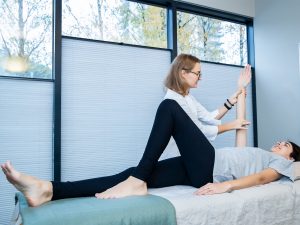
What is kinesiology?
Applied Clinical Kinesiology (hereinafter ACK) belongs to the field of manual therapy and diagnostics. It can be applied in various medical fields: orthopedics, rehabilitation, kinesitherapy, dentistry, psychotherapy. A kinesiologist, using manual muscle testing, i.e. testing muscle reflexes, obtains a neurophysiological response from the central nervous system (hereinafter CNS): certain muscles have direct and indirect connections with internal organs and other body systems. This is how the therapist communicates with the patient’s body. Thus, by testing different muscles, the therapist determines whether they are functionally normotonic (normally functioning), hypertonic (unable to fully relax), or hypotonic (unable to fully engage). After finding a hypotonic muscle, the therapist stimulates different body areas to find which one will restore normotonic state. This indicates the appropriate manual treatment.
ACK is classified as holistic medicine and combines many therapeutic disciplines such as: manual therapy, osteopathy, chiropractic, homeopathy, phytotherapy, psychotherapy, etc. ACK is based on the health triad principle: meaning our health is a balance formed in structural (what we can touch – muscles, bones, internal organs, nerves, blood vessels), biochemical (metabolism, immune, endocrine, autonomic systems), and psycho-emotional (feelings, emotions, thinking, behavior, reflexes, subconscious) dimensions. This diagnostic and therapeutic methodology is individualized and has no routine. Each time, even for the same patient, is different.
“Man is a receptor-governed being”
(Allen, 1995)
Where and when is kinesiology used?
ACK treats health disorders not as conditions (e.g., headache or migraine) but as processes: they may be consequences of jaw joint, pelvis, or foot dysfunction, or allergies. Thus, the CAUSE of the headache must be found and corrected. Kinesiologists also believe that the most important are the body’s self-regulatory mechanisms, which are activated during therapy. Dr. Goodheart discovered the interrelationship between nutrition, internal organs and muscle function. For example, a functionally weak “musculus teres minor” (small round muscle) is associated with thyroid dysfunction. When the patient is given a small dose of iodine, this muscle recovers!
Thus, it is obvious that ACK is an excellent diagnostic methodology.
“The body heals itself – safely, intelligently and wisely. The inner physician can be awakened from outside”
(Dr. J. Goodheart)
History of kinesiology
The history of ACK began in 1964, its discoverer and first patient was American doctor J. Goodheart. He himself suffered from chronic shoulder pain. While palpating his shoulder he found a painful spot. After massaging it, he noticed that the shoulder muscle strength recovered. This was the beginning of a long journey. Observing his discoveries, Dr. Goodheart expanded his diagnostic and therapeutic system from the structural side. He integrated into ACK the methodologies of Dr. Chapman (osteopath) and Dr. Bennett (chiropractor), which studied reflex stimulation to improve lymphatic and internal systems. In 1969, acupuncture science was incorporated into ACK, in the 1970s craniosacral osteopathy according to Dr. Sutherland, and later according to Dr. Upledger. In 1976, the first joint orthodontics/dentistry and ACK diagnostic studies were conducted.




